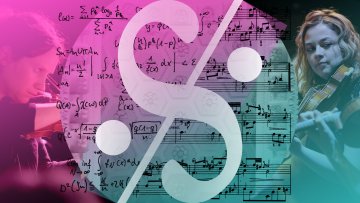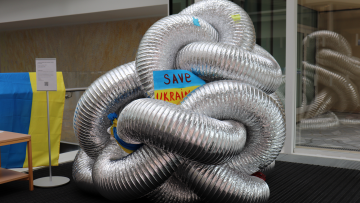J.S. Bach is sometimes described as the mathematician's musician. But why is that?
James Sparks is a professional mathematician here in Oxford; but he was also an organ scholar as an undergraduate in Cambridge and he is fascinated by the mathematical aspect of Bach's work.
On June 30th James will open the Spitalfields Music Festival 2022 with a talk on the 'Mathematical Genius of Bach'. He will be followed by the City of London Sinfonia playing the Goldberg Variations where that genius reaches its apogee.
There is a lot of construction, renovation and general moving of stuff going on around the University and City just now.
Now, no doubt it is all being done with 100% efficiency, but just in case here is the definitive 'work not getting done' tribute. Incidentally the song was recorded in the same studio where, a few months later, the Beatles changed the face of popular music.
Bridging the divide: from matrix to tensor algebra for optimal approximation and compression
Abstract
Tensors, also known as multiway arrays, have become ubiquitous as representations for operators or as convenient schemes for storing data. Yet, when it comes to compressing these objects or analyzing the data stored in them, the tendency is to ``flatten” or ``matricize” the data and employ traditional linear algebraic tools, ignoring higher dimensional correlations/structure that could have been exploited. Impediments to the development of equivalent tensor-based approaches stem from the fact that familiar concepts, such as rank and orthogonal decomposition, have no straightforward analogues and/or lead to intractable computational problems for tensors of order three and higher.
In this talk, we will review some of the common tensor decompositions and discuss their theoretical and practical limitations. We then discuss a family of tensor algebras based on a new definition of tensor-tensor products. Unlike other tensor approaches, the framework we derive based around this tensor-tensor product allows us to generalize in a very elegant way all classical algorithms from linear algebra. Furthermore, under our framework, tensors can be decomposed in a natural (e.g. ‘matrix-mimetic’) way with provable approximation properties and with provable benefits over traditional matrix approximation. In addition to several examples from recent literature illustrating the advantages of our tensor-tensor product framework in practice, we highlight interesting open questions and directions for future research.
On June 27th, in the Reception area of the Mathematical Institute, Oxford artist Andy Bullock unveiled his most ambitious knot sculpture to date, a large floor-based work titled ‘All we ever wanted was everything / 24.02.22 (for Ukraine)’ constructed using 70 metres of metal trunking. As with all his knot sculptures they often reference issues of complexity with situations and people, the personal and interpersonal; focusing on what it means to be human.



